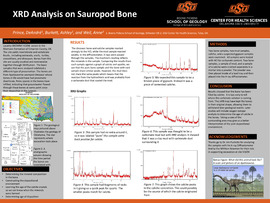| dc.contributor.author | Prince, DeAndre | |
| dc.contributor.author | Burkett, Ashley | |
| dc.contributor.author | Weil, Anne | |
| dc.date.accessioned | 2020-05-05T19:37:56Z | |
| dc.date.available | 2020-05-05T19:37:56Z | |
| dc.date.issued | 2020-02-28 | |
| dc.identifier | ouhd_prince_XRDanalysisonsauropod_2020 | |
| dc.identifier.citation | Prince, D., Burkett, A., & Weil, A. (2020, Feb. 28). XRD analysis on sauropod bone. Poster presented at Research Day at Oklahoma State University Center for Health Sciences, Tulsa, OK. | |
| dc.identifier.uri | https://hdl.handle.net/11244/324237 | |
| dc.description.abstract | Sauropod bones recovered from SNOMNH V1694, a dinosaur-bearing site in the Late Jurassic Morrison Formation of Oklahoma, are variably permineralized by calcite. We suspect that the bones were first buried and then infilled by the calcite. The time at which permineralization occurred is unclear, because recent soil carbonates can be found at the site and ancient soil carbonates can be found in nearby outcrops of the Morrison Formation, indicating that groundwater has carried calcium carbonate through the sediments at different times. Twelve bone samples collected in June 2019, and mineral samples from the surrounding sediments, were crushed and processed using X-ray diffraction to determine how much of the bone was infilled by calcite and the mineral composition of each sample to determine the source. To test these samples, we used a mortar to crush them into a fine powder, we then took the powder and spread it across a lead plate and put it into the X-ray Diffractometer. While in the machine X-rays are then passed through the sample, we receive what it is called a peak. These peaks reveal what minerals comprise a sample. Testing these samples showed that the mineral composition of the bone infill was calcite due to the peaks shown in the graphs. In sample one of the bones, there was a peak at 1600 which determined that what has infilled the bone is calcite. In sample two, there was a peak at 600 which shows calcite and another peak at 550 which is determined as quartz. Samples of the mud showed that there was no correlation with the bone. This means that the mud is not viable source for the precipitated calcite. These results suggest the source of the calcite could be from a different type of sediment or groundwater could be coming from a source that is rich with carbonate minerals and transporting the dissolved minerals into the bone pores. In the future, analysis of stable oxygen isotopes may help determine whether the calcite infill is related to recent groundwater movement or whether it is more ancient. | |
| dc.format | application/pdf | |
| dc.language | en_US | |
| dc.publisher | Oklahoma State University Center for Health Services | |
| dc.rights | The author(s) retain the copyright of have the right to deposit the item giving the Oklahoma State University Library a limited, non-exclusive right to share this material in its institutional repository. Contact Digital Resources and Discovery Services at lib-dis@okstate.edu or 405-744-9161 for the permission policy on the use, reproduction or distribution of this material. | |
| dc.title | XRD analysis on sauropod bone | |
| osu.filename | ouhd_prince_XRDanalysisonsauropod_2020.pdf | |
| dc.type.genre | Presentation | |
| dc.type.material | Text | |
| dc.subject.keywords | x-ray diffraction (xrd) | |
| dc.subject.keywords | sauropod | |
| dc.subject.keywords | groundwater | |
| dc.subject.keywords | calcite | |
